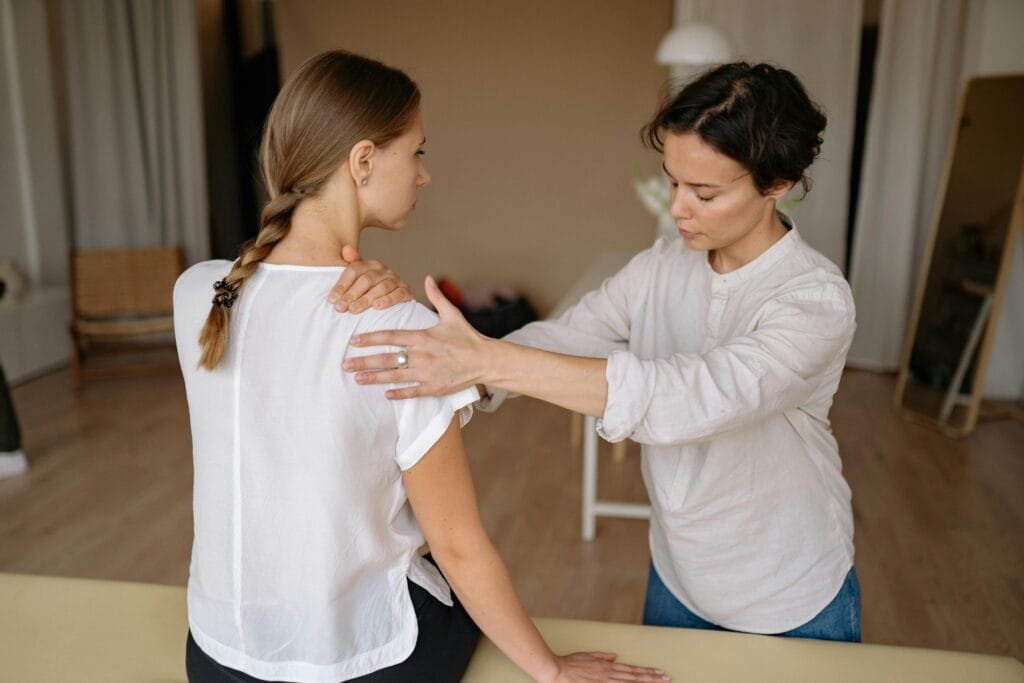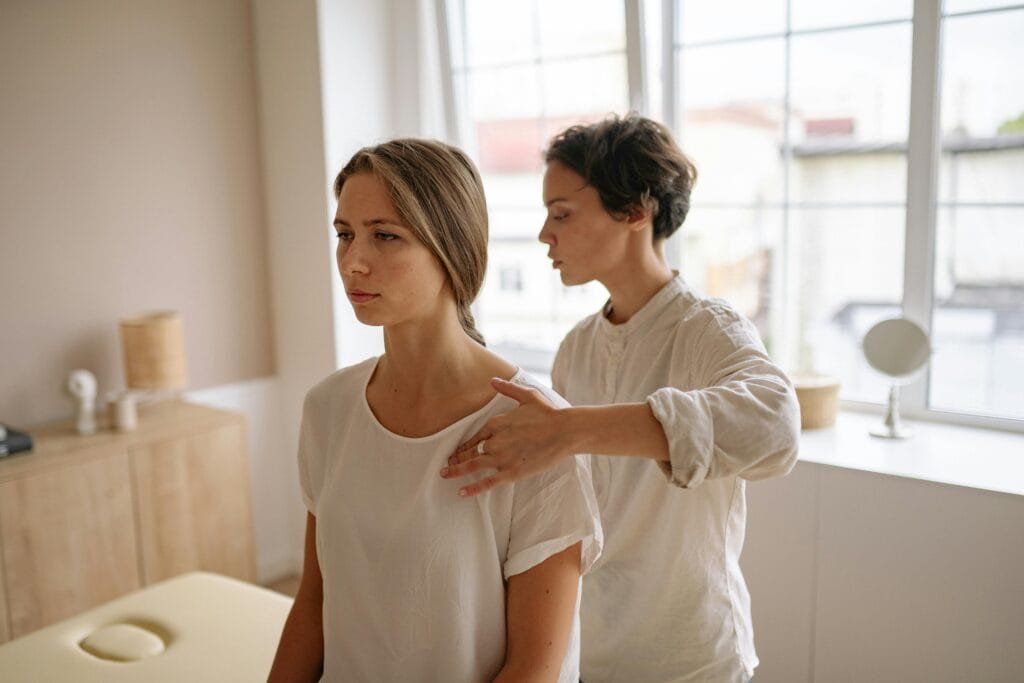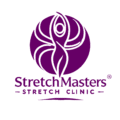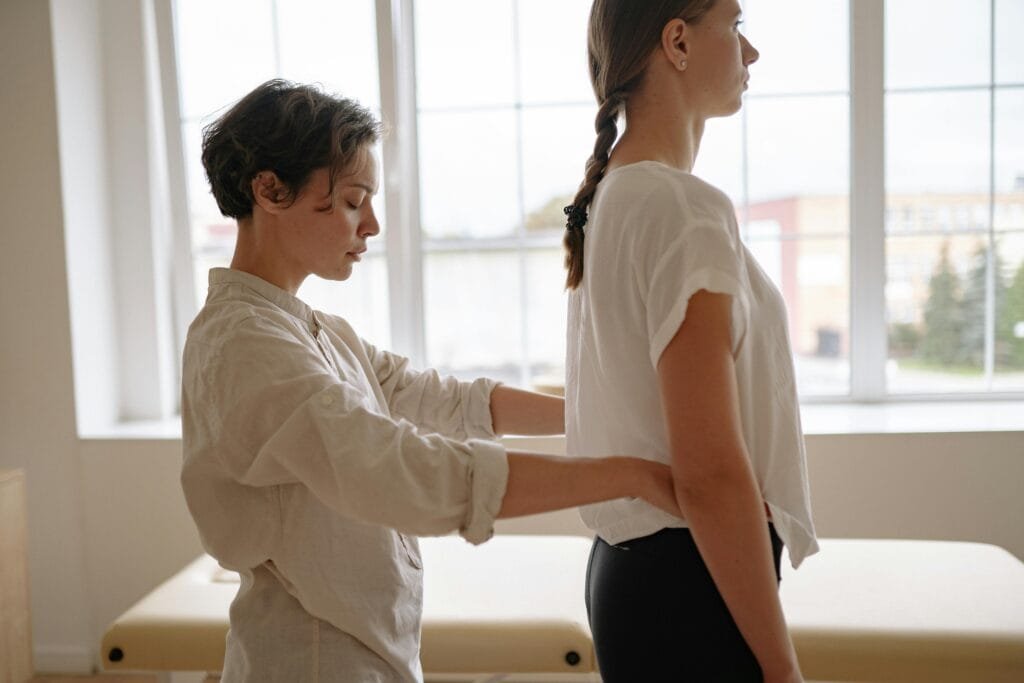In today’s world, many people spend long hours seated at desks, driving, or looking down at screens – and postural challenges have become increasingly common. Rounded shoulders, a forward head position, and general back tension are frequent signs of this modern lifestyle. While no quick fix exists, there are ways to support better posture, reduce muscular tension, and improve movement quality.
Assisted stretching, delivered by trained professionals, offers a targeted, hands-on approach that may help promote more balanced posture, increase mobility, and encourage greater body awareness – key elements in maintaining long-term musculoskeletal health.
What Exactly is Assisted Stretching and How Does it Work?
Assisted stretching is a specialized form of stretching where a trained professional, such as a stretch specialist or stretch therapist, guides your body through a series of stretches. Unlike self-stretching, this method allows for a greater range of motion because the practitioner can apply external force, helping you to relax deeper into the stretch.
A key technique often employed is Proprioceptive Neuromuscular Facilitation (PNF) stretching. This isn’t just about passive pulling; it’s a sophisticated, collaborative dance involving alternating cycles of muscle contraction and relaxation. The practitioner will guide you to gently resist a stretch, then relax, allowing the muscle to achieve a greater length. This process cleverly “re-calibrates” your nervous system, specifically influencing the stretch reflex to permit a deeper, safer, and more effective stretch than you could achieve on your own. Research, such as that by Sharman et al. (2006), consistently shows PNF significantly enhances flexibility and range of motion, laying crucial groundwork for improved posture.
How Can Assisted Stretching Improve Posture? The Biomechanics Behind the Balance
Poor posture often stems from muscle imbalances – where some muscles become tight and shortened, while their opposing counterparts become weak and over-lengthened. Think of your body as a complex pulley system; if one rope is too tight and another too slack, the whole structure can tilt out of alignment.
Assisted stretching specifically targets and lengthens those tight, restrictive muscles. Simultaneously, it can help awaken and strengthen the weaker, elongated muscles by allowing them to function at their optimal length. This supports balanced muscle function, which plays an important role in maintaining healthy posture.
Let’s look at some common postural culprits and how assisted stretching addresses them:
- Rounded Shoulders (Upper Crossed Syndrome): Often caused by tight chest muscles (pectorals) and weak upper back muscles. Assisted stretching opens up the chest, allowing your shoulders to pull back naturally.
- Forward Head Posture: Driven by tight neck extensors and weak deep neck flexors. Stretching releases tension in the neck and upper back, helping to bring your head back into alignment over your spine.
- Anterior Pelvic Tilt (Lower Crossed Syndrome): A common issue from prolonged sitting, where tight hip flexors pull the pelvis forward, often leading to an exaggerated curve in the lower back and associated pain. Assisted stretching effectively releases these hip flexors (Kendall et al., 2005), allowing the pelvis to return to a neutral position.
Assisted stretching can support more balanced movement by encouraging muscle coordination and joint mobility. This may help your body move more efficiently and with less perceived tension, promoting healthy biomechanics in everyday activity.
Which Muscles or Body Parts Are Most Targeted in Assisted Stretching for Posture?
To truly correct posture, a stretch specialist focuses on the key muscle groups that contribute to imbalances. Here’s a breakdown of common targets:
| Muscle Group / Body Part | Why it’s Targeted for Posture | Contribution to Postural Issues |
| Cervical Spine (Neck) | Releases tension in the neck and upper trapezius, improving head alignment. | Forward head posture, tech neck, headaches. |
| Thoracic Spine (Upper Back) | Enhances extension and rotation in the mid-back, counteracting slouching. | Rounded shoulders, hunched upper back (Balthillaya et al., 2022). |
| Shoulders / Pectorals (Chest) | Lengthens tight chest muscles, allowing shoulders to roll back and down. | Rounded shoulders, slumped posture. |
| Hip Flexors | Releases tension from prolonged sitting, allowing the pelvis to neutralise. | Anterior pelvic tilt, lower back arch and pain (Kendall et al., 2005). |
| Hamstrings & Glutes | Improves pelvic alignment and supports the lower back. | Pelvic imbalances, compensatory postures. |
| Lats (Latissimus Dorsi) | Reduces internal rotation of shoulders, promoting an open chest. | Rounded shoulders, restricted overhead movement. |
How Often Should I Do Assisted Stretching for Posture Improvement?
Consistency is absolutely crucial for lasting postural change. For initial improvement, 1-2 sessions per week are often recommended. This frequency allows your body to adapt to new ranges of motion and for your nervous system to “relearn” healthier positions.
Once significant progress is made, many clients transition to maintenance sessions, typically every 2-4 weeks. This helps to retain flexibility gains and prevent old habits from creeping back in. Your stretch specialist will work with you to create a personalized plan based on your specific needs and goals.

Is Assisted Stretching Safe for Seniors or People with Injuries?
Yes – when delivered by a qualified and experienced professional, assisted stretching may be beneficial for older adults. It can help support mobility, reduce feelings of stiffness, and contribute to better movement confidence. These outcomes are particularly valuable in maintaining independence and physical wellbeing over time.
For individuals with existing injuries or health conditions, a qualified stretch professional – especially a physiotherapist – will carry out a thorough history and movement assessment before beginning any session. This helps ensure that stretches are safe, appropriate, and adapted to individual needs. While assisted stretching is not a replacement for medical treatment, it may complement recovery plans when delivered responsibly and with clinical oversight. Always communicate any discomfort or concerns during a session.
What Should I Expect During an Assisted Stretching Session?
A typical assisted stretching session is a personalized experience designed to target your unique needs:
- Consultation & Assessment: Your session will likely begin with a discussion about your health history, lifestyle, specific pain points, and postural goals. The therapist may perform a postural assessment to identify muscle imbalances and areas of tightness.
- Guided Stretching: You’ll lie or sit comfortably on a massage table or mat. The stretch specialist will then gently move your limbs and body into various stretches, guiding you to breathe deeply and relax into the movement.
- Active Participation: While “assisted,” it’s a collaborative effort. The therapist might ask you to gently contract a muscle against their resistance, a key part of the PNF technique to deepen the stretch.
- Targeted Release: The therapist may incorporate techniques like myofascial release or gentle massage to address particularly tight areas and trigger points.
- Post-Session Guidance: After the session, your therapist might provide advice on self-stretches, exercises, or ergonomic adjustments to help maintain your progress between visits.
The experience is generally relaxing and invigorating, leaving you feeling lighter, looser, and more aligned.
What Are the Main Benefits of Assisted Stretching Besides Posture?
While posture correction is a primary focus, assisted stretching offers a cascade of other compelling benefits that contribute to overall well-being and physical performance:
- Increased Flexibility & Range of Motion: The most immediate and noticeable benefit. By gently pushing your limits, you unlock a greater capacity for movement in your joints and muscles.
- Reduced Muscle Soreness & Pain: Regular stretching, especially of tight areas like the hamstrings and hip flexors, can alleviate chronic muscle tension and the associated discomfort. Research supports that improved flexibility, particularly in these areas, can significantly alleviate lower back pain (Smith et al., 2014).
- Injury Risk Reduction: Improving flexibility and addressing muscle imbalances may help reduce the risk of certain movement-related injuries, such as strains or sprains. When delivered by trained professionals, assisted stretching can support better movement patterns and body awareness – both of which play a role in maintaining musculoskeletal health.
- Enhanced Mobility & Movement Efficiency: Greater flexibility translates directly into easier, more fluid everyday movements, whether you’re reaching for something on a high shelf or tying your shoes.
- Improved Athletic Performance: Athletes often incorporate assisted stretching to prepare their bodies for demanding activities, enhance power, and speed up recovery.
- Better Blood Circulation: Stretching can promote blood flow to your muscles, aiding in nutrient delivery and waste removal.
- Stress Reduction & Relaxation: The physical release of tension through stretching also has a profound calming effect on the nervous system, reducing mental and physical stress.
- Heightened Body Awareness: Through the guided movements and the active-passive phases, you develop a much deeper understanding of your body’s capabilities and limitations, fostering a stronger mind-body connection. This enhanced proprioceptive awareness is vital for maintaining good posture intuitively throughout your day.
How Does Assisted Stretching Differ from Self-Stretching?
While self-stretching is beneficial, assisted stretching offers distinct advantages, particularly when targeting deep-seated postural issues:
| Feature | Self-Stretching | Assisted Stretching |
| Depth of Stretch | Limited by your own flexibility and strength. | Practitioner can push beyond your self-imposed limits safely, achieving deeper stretches. |
| Accuracy | Prone to incorrect form, potentially leading to injury or ineffective stretching. | Expert guidance ensures correct alignment and targeting of specific muscles. |
| Muscle Activation | Primarily passive or static. | Incorporates PNF techniques (contract-relax) to engage and “trick” the nervous system for greater release. |
| Relaxation | Requires active effort, can be difficult to fully relax. | You can fully relax while the practitioner does the work, allowing for deeper release. |
| Targeting | General, often missing key problem areas. | Precise targeting of specific tight muscles contributing to postural imbalances. |
| Effectiveness | Good for maintenance, but limited for significant gains. | Highly effective for rapidly increasing flexibility, reducing pain, and correcting chronic issues (Warneke et al., 2024). |
| Safety | Risk of overstretching or injury if performed incorrectly. | Reduced risk of injury due to expert knowledge of anatomy and contraindications. |

Are There Specific Stretches That Target Posture Correction?
Absolutely. A skilled stretch therapist will employ a range of techniques tailored to your specific postural imbalances. Here are some common approaches:
- Chest and Shoulder Openers: Stretches targeting the pectorals and anterior deltoids to counteract rounded shoulders and facilitate a more upright posture.
- Thoracic Spine Mobility: Techniques that increase extension and rotation in the upper back to alleviate a hunched posture and improve overall spinal alignment (Balthillaya et al., 2022).
- Hip Flexor Stretches: Deep, sustained stretches for the hip flexors (iliopsoas, rectus femoris) to reduce anterior pelvic tilt and alleviate lower back strain (Kendall et al., 2005).
- Hamstring and Glute Lengthening: Stretches that improve the flexibility of the posterior chain, supporting a neutral pelvis and healthy lumbar curve.
- Neck and Upper Trapezius Release: Gentle stretches and manual techniques to alleviate tension in the neck and shoulders often associated with forward head posture and “tech neck.”
- Myofascial Release (MFR): This involves applying sustained pressure to connective tissue (fascia) to release restrictions and improve tissue mobility. MFR can be highly effective in addressing specific “knots” and tightness that contribute to postural dysfunction (Warneke et al., 2024).
These stretches are performed with precise angles and intensities that are difficult, if not impossible, to achieve effectively on your own.
How Long Does It Take to See Results in Posture from Assisted Stretching?
The timeline for seeing noticeable improvements in posture from assisted stretching can vary, but generally, clients often report feeling initial changes within a few weeks to a month of consistent sessions. More significant, visible postural corrections typically become apparent over two to three months.
However, it’s important to understand that this is an individualized journey. Factors influencing your progress include:
- Severity of current postural issues: More ingrained habits may take longer to address.
- Consistency of sessions: Regularity is key to reinforcing new movement patterns.
- Your active participation: While assisted, your engagement in relaxing into the stretch and practicing newfound awareness outside of sessions significantly impacts results.
- Adherence to practitioner advice: Incorporating recommended exercises or stretches into your daily routine.
- Lifestyle factors: Continuing a sedentary lifestyle or poor ergonomic habits can slow progress.
Think of it as a gradual re-education of your body. Consistency is absolutely crucial, allowing your muscles and nervous system to adapt to new, healthier positions. Many clients choose ongoing maintenance sessions to sustain their improved posture and flexibility long-term.
Can Assisted Stretching Help with Back or Neck Pain?
Assisted stretching may help some individuals manage general muscular tension in the back or neck, particularly when it’s related to postural habits or restricted mobility. While it’s not a treatment for chronic pain, professionally guided stretching can support mobility, flexibility, and body awareness – all of which contribute to more comfortable movement. Always consult a qualified physiotherapist if you’re experiencing ongoing pain.
- Neck Pain: A common culprit is forward head posture, where your head protrudes forward of your shoulders. This significantly increases the load on your cervical spine, leading to muscle strain, stiffness, and even headaches (Yip et al., 2008). Assisted stretching can release the tight muscles pulling your head forward, allowing it to realign and alleviating undue stress.
- Back Pain: Similarly, tight hip flexors can pull your pelvis into an anterior tilt, exacerbating the curve in your lower back (lumbar lordosis) and contributing to persistent lower back pain (Kendall et al., 2005). Assisted stretching effectively lengthens these muscles, allowing your pelvis to return to a neutral position and reducing strain on your spine.
By addressing muscular tension and promoting balanced movement, assisted stretching may help ease general discomfort in areas such as the back or neck. However, always consult with a healthcare professional, such as your GP or a physiotherapist, to rule out any underlying conditions before using stretching as part of your pain management approach.
Do I Need to Warm Up Before an Assisted Stretching Session?
Generally, no extensive warm-up is required before an assisted stretching session. Your stretch therapist will typically start with gentle, passive movements to gradually prepare your muscles and tissues for deeper stretches. The initial phase of the session serves as its own built-in warm-up.
While you don’t need to do a full workout, arriving at your session feeling relaxed and with your muscles not completely cold is beneficial. A brisk walk or light movement beforehand can be helpful, but it’s not essential. The professional will guide you through all necessary preparations.
What Qualifications Should a Stretch Therapist Have?
Choosing a qualified stretch therapist is paramount for safety and effectiveness. Look for practitioners with backgrounds in:
- Sports Therapy or Sports Rehabilitation: These professionals have a deep understanding of musculoskeletal anatomy, injury mechanisms, and recovery.
- Physiotherapy: Physiotherapists are highly trained in movement, function, and rehabilitation, making them excellent candidates for providing assisted stretching. (In the UK, verify they are registered with the Health and Care Professions Council and the Chartered Society of Physiotherapy).
- Massage Therapy with Specialisation: Some massage therapists pursue advanced training in stretching techniques and bodywork.
- Certified Stretch Specialist Programs: Dedicated certifications from reputable organizations that focus solely on assisted stretching modalities.
Don’t hesitate to ask about their credentials, experience, and what their specific training involved. A professional will be transparent and happy to share this information.
Are There Risks or Side Effects to Assisted Stretching?
When performed by a qualified and experienced professional, assisted stretching is generally considered very safe. The primary “side effect” is often mild, temporary muscle soreness (similar to post-workout soreness) as your muscles adapt to new lengths. This typically subsides within 24-48 hours.
Potential risks, though rare with a competent practitioner, can include:
- Muscle strain or sprain: If a stretch is forced or taken too far too quickly.
- Nerve irritation: If proper anatomical understanding is lacking.
This is precisely why choosing a certified and experienced therapist is crucial. They understand the body’s limits, contraindications, and how to work safely within your comfort zone. Always communicate any discomfort or sharp pain immediately during a session. Responsible advertising, as per ASA guidelines, always highlights the importance of qualified practitioners and managing expectations around health claims.
Can Assisted Stretching Be Combined with Other Therapies or Exercises?
Yes – when guided by a qualified professional, assisted stretching can often complement other exercise or movement-based approaches such as strength training, yoga, or physiotherapy. It may help improve flexibility, body awareness, and recovery, making it a supportive addition to many fitness or wellness routines. Always consult a relevant healthcare provider when combining approaches, especially if you’re managing an injury or medical condition. It can be seamlessly integrated with:
- Strength Training: Improved flexibility from stretching allows for a greater range of motion during exercises, leading to more effective strength gains and reduced injury risk.
- Yoga or Pilates: Assisted stretching can deepen your practice by unlocking new flexibility and improving body awareness, making these disciplines even more beneficial.
- Chiropractic or Osteopathic Treatment: Releasing muscle tension through stretching can help maintain spinal alignment achieved during adjustments.
- Massage Therapy: Combining stretching with massage can provide comprehensive relief from muscle tightness and fascial restrictions.
- Physiotherapy/Physical Therapy: As part of a rehabilitation program, assisted stretching can help restore lost range of motion and accelerate recovery from injuries.
Your stretch specialist can advise you on how to best combine assisted stretching with your current fitness and wellness routine for optimal results.

Limitations of Assisted Stretching
While assisted stretching can be highly supportive, it’s important to recognise that it’s not a cure-all and has its limitations. It may be particularly helpful in managing muscular tension and supporting better movement patterns, especially where these factors influence posture. For more complex conditions or persistent concerns, consultation with a physiotherapist or other healthcare professional is advised.
Assisted Stretching cannot:
- Correct Structural Abnormalities: If your postural issue stems from a bone deformity, scoliosis, or other skeletal abnormalities, assisted stretching may help manage symptoms but won’t “fix” the underlying structural problem.
- Heal Acute Injuries: If you have a recent muscle tear, fracture, or severe inflammation, stretching could worsen the condition. Acute injuries require medical diagnosis and often rest before rehabilitation.
- Treat Neurological Conditions: Postural issues arising from neurological disorders (e.g., Parkinson’s, stroke) require specialized medical and rehabilitative care.
- Resolve Inflammatory Conditions: Conditions like arthritis with active inflammation may be aggravated by stretching.
For any persistent pain, numbness, tingling, or if you suspect a serious underlying condition, always consult your GP or a physiotherapist for a proper diagnosis and treatment plan. Assisted stretching works best as part of a holistic approach to health and wellness.
Conclusion: Stand Tall, Live Fully
Posture is more than just how you hold yourself – it reflects underlying movement habits and musculoskeletal function, influencing how you feel and carry yourself each day. Assisted stretching offers a guided, hands-on approach that may help reduce muscular tension, support postural awareness, and encourage more balanced movement.
By working with a trained professional, you’re taking a proactive step toward greater comfort, mobility, and overall wellbeing. It’s an investment in moving with confidence and living more freely – starting with how you stand today.
Related Blogs from Stretch Master
- Unlock Your Potential: The Benefits of Professional Stretching
- Stretching for Athletes: Optimise Your Performance and Prevent Injuries
- Deskbound Warriors: The Ultimate Guide to Stretching for Office Workers
References
- Balthillaya GM, et al. (2022). “Effectiveness of posture-correction interventions for mechanical neck pain: Systematic review and meta-analysis.” BMJ Open. 2022;12(3):e054691. https://bmjopen.bmj.com/content/12/3/e054691
- Kendall FP, McCreary EK, Provance PG et al. Muscles: Testing and Function with Posture and Pain (5th ed). Baltimore: Lippincott Williams & Wilkins, 2005.
- Sharman, M. J., Cresswell, A. G., & Riek, R. F. (2006). Proprioceptive Neuromuscular Facilitation (PNF) stretching: Mechanisms and clinical implications. Sports Medicine, 36(11), 929–939. https://doi.org/10.2165/00007256-200636110-00002
- Smith BE, Littlewood C, May S. An update of stabilisation exercises for low back pain: a systematic review with meta-analysis. BMC Musculoskelet Disord. 2014 Dec 9;15:416. doi: 10.1186/1471-2474-15-416. PMID: 25488399; PMCID: PMC4295260. https://pubmed.ncbi.nlm.nih.gov/25488399/
- Warneke K, et al. (2024). “Effects of Stretching or Strengthening Exercise on Spinal Posture: A Systematic Review and Meta-Analysis.” Sports Med. 2024;54(6):1137-1151. https://pmc.ncbi.nlm.nih.gov/articles/PMC11150224/
- Yip CH, Chiu TT, Poon AT. The relationship between head posture and severity and disability of patients with neck pain. Man Ther. 2008 May;13(2):148-54. doi: 10.1016/j.math.2006.11.002. Epub 2007 Mar 23. PMID: 17368075. https://pubmed.ncbi.nlm.nih.gov/17368075/
Disclaimer:
The content on this blog is provided for general information and wellness purposes only. It should not be considered medical advice, diagnosis, or treatment. StretchMasters® services, including assisted stretching, are intended to support overall wellbeing and are not a substitute for professional healthcare guidance. While reasonable care has been taken in preparing and verifying the information presented in this blog, StretchMasters® makes no claims, representations, or guarantees regarding its completeness, accuracy, reliability, suitability or availability with respect to the website or the information, products, services, or related graphics contained on the website for any purpose. This content is intended for general informational purposes only and is not a scientific article. Inconsistencies, inaccuracies, or errors — including in paraphrasing and citation — may be present. Any reliance you place on such information is therefore strictly at your own risk. We strive to ensure that all information is accurate and up to date; however, due to the evolving nature of health research, we cannot guarantee that all content reflects the latest evidence. Additionally, external links shared in blog posts may change, be updated, or become inactive over time without notice. Always consult with a qualified medical professional before starting any new therapy, especially if you have existing health conditions. StretchMasters®, its parent company Skuil Ltd, and affiliated clinics accept no liability for decisions made based on this content. Opinions expressed in individual blog posts are those of the authors and do not necessarily reflect the views or policies of StretchMasters® or its subsidiaries. Any reference to third-party organisations, websites, services, or products is not an endorsement.

